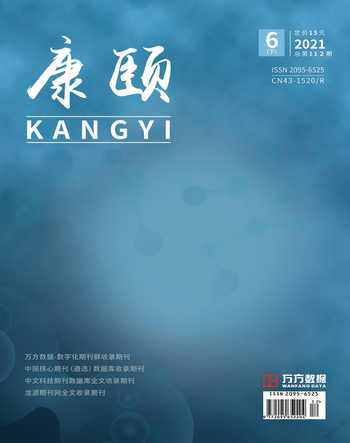髂腰肌A型肉毒毒素注射配合康复治疗对儿童痉挛型脑瘫步行能力的影响
吴英 李脉

【摘要】目的:探討髂腰肌A型肉毒毒素注射配合康复治疗对儿童痉挛型脑瘫步行能力的影响。方法:选择进行了髂腰肌注射的痉挛型脑瘫患儿40例作为治疗组,未进行髂腰肌注射的痉挛型脑瘫患儿40例作为对照组。治疗组进行了包含髂腰肌在内的痉挛肌群的A型肉毒毒素的注射治疗,对照组进行了除髂腰肌注射以外的抗痉挛治疗。结果:(1)治疗1个月、2个月、3个月,两组脑瘫儿童GMFM88中与爬、跪、站立及步行能力有关的分值治疗前、后差异有统计学意义(P<0.01),治疗组和对照组在治疗后差异有显著性(P<0.01)。(2)治疗组的伸髋角度及髂腰肌改良Ashworth分级(MAS)在治疗后3天、7天、1个月、2个月均有明显改善,与治疗前比差异有显著性(P<0.01),3个月时伸髋角度有所下降、髂腰肌改良Ashworth分级有所增加,但均未回复到治疗前水平(P<0.05);对照组的伸髋角度及髂腰肌改良Ashworth分级在治疗后3天、7天治疗前比差异无显著性(P>0.05),治疗后1个月、2个月、3个月较治疗前有显著改善(P<0.05);治疗组与对照组在治疗后3天、7天、1个月、2个月、3个月的差异有显著性(P<0.01),治疗组优于对照组。(3)父母的报告:起效时间为注射后48-72小时,到达高峰时间为1个月左右,疗效维持>3个月,有大部分患儿3个月时疗效开始减弱,但未回复到注射前。大部分患儿注射后的不良反应表现为无力,大约持续一周左右消失。结论:髂腰肌A型肉毒毒素注射配合康复治疗对改善痉挛型脑瘫患儿爬、跪、站立及步行的能力有显著疗效。
【关键词】脑瘫;痉挛;髂腰肌;A型肉毒毒素
【中图分类号】R742.3 【文献标识码】A 【DOI】10.12332/j.issn.2095-6525.2021.12.010
A botulinum toxin injection with rehabilitation treatment for children spasastic
cerebral palsy Impact of the walking capacity
Wu Ying , Li Mai *
the Second Affiliated Hospital of Kunming Medical University, Kunming 650000
【Abstract】Objective:To investigate injection of botulinum toxin type A on Iliopsoas matching rehabilitation to therapy children with spastic cerebral palsy . Methods: 40 patients with spastic cerebral palsy with iliolumbar muscle injection were selected as treatment groups, and 40 children with spastic cerebral palsy without iliolumbar muscle injection were selected as control groups. The treatment group performed the injection treatment of type A botulinum toxin in the spasmodic muscle group including the iliotenac muscle, and the control group underwent the antispasticity therapy in addition to the iliotenac muscle injection. Results: (1) One month, 2 month, 3 months, GMFM88 with climbing, kneeling, standing and walking ability (P <0.01) and significant differences in the treatment and control groups (P < 0.01). (2) Treatment group hip angle and iliolumbar muscle improvement Ashworth classification (MAS) improved significantly after treatment 3 days, 7 days, 1 month, 2 months, significant with pre-treatment ratio (P<0.01), decreased hip extension at 3 months, but not returned to pretreatment level (P <0.05); control group hip angle and iliolumbar muscle improvement Ashworth classification were not significant at 3 days and 7 days after treatment (P> 0.05), 1 month, 2 months, 3 after treatment There was significant improvement in months before treatment (P <0.05); there was significant differences between the control group at 3 days, 7 days, 1 month, 2 month, 3 months after treatment (P <0.01) and better than the control group. (3) Parents ' report: the starting time is 48-72 hours after injection, the peak time is about 1 month, the efficacy is maintained by> for 3 months, most children began to weaken at 3 months, but did not reply before injection. Most children ' adverse reactions after injection showed weakness and disappeared for about a week. Conclusion: A botulinum toxin injection with rehabilitation therapy to improve spasm The ability of children with type 4, cerebral palsy to climb, kneel, stand and walk on cerebral palsy has remarkable efficacy.
【Key words】Cerebral Palsy; spasm; iliolumbar muscle; botulinum toxin type A
痉挛型脑瘫是脑瘫的常见类型,约占60%—70%[1],抗痉挛治疗是脑瘫康复过程中的一个关键问题。近年来,A 型肉毒毒素已经被用来治疗痉挛型脑瘫患儿[1]。由于髂腰肌痉挛会造成脑瘫儿童髋关节屈曲的异常姿势,对患儿站立、行走功能均有一定的影响,阻碍运动功能的正常发育 。对于降低髂腰肌肌张力,传统的方法是进行被动关节活动训练,但效果往往欠佳,因此本研究的目的在于对髂腰肌进行A型肉毒素注射配合康复治疗是否能有效改善患儿的步行能力。
1 资料与方法
1.1 病例资料
选择2007年5月后我科开展髂腰肌A型肉毒毒素注射的儿童痉挛性脑瘫40例作为治疗组,2007年5月前尚未开展髂腰肌A型肉毒毒素注射的儿童痉挛性脑瘫40例作为对照组,两组患儿均为痉挛性截瘫,两组具有较好的均衡性、可比性,除了髂腰肌注射外,两组的其他治疗方法均相同。本文对患儿步行能力的评价采用粗大运动功能88 项(GMFM88)中与爬、跪、站立及步行能力有关的项目进行评价,痉挛肌分级采用改良Ashworth分级(MAS)。
1.2 方法
单侧髂腰肌剂量确定:根据肌腹的大小,痉挛的程度来确定。治疗组的平均注射剂量为48u,最大注射剂量为100u,分2日(连续2天)注射。使用兰州生物制品所生产的A型肉毒毒素粉针剂,每安培含100U-110U,以0.9%生理盐水2ml严格按A型肉毒毒素的溶解方法进行溶解稀释,浓度为50-55u/ml,每点10u/0.2ml。
2 结果
2.1关节活动范围及痉挛肌改良Ashworth评分的变化
治疗组的伸髋角度及髂腰肌改良Ashworth分级在治疗后3天、7天、1个月、2个月、3个月均有明显改善,与治疗前比差异有显著性(P<0.01),治疗1个月时效果最显著(P<0.001);对照组的伸髋角度及髂腰肌改良Ashworth分级在治疗后3天、7天无明显改善,与治疗前比差异无显著性(P>0.05),治疗后1个月、2个月、3个月较治疗前有显著改善(P<0.05);治疗组与对照组的伸髋角度及髂腰肌改良Ashworth分级在治疗后3天、7天、1个月、2个月、3个月的差异有显著性(P<0.01),治疗组优于对照组;治疗组与对照组的腘窝角、直腿抬高角、踝背伸角及内收肌角治疗前、后差异有显著性(P<0.05),治疗组与对照组治疗后的腘窝角、直腿抬高角、踝背伸角及内收肌角差异无显著性(P>0.05)。(见下表)。
2.2粗大运动评分(GMFM-88)的变化
治疗1个月、2个月、3个月,两组脑瘫儿童粗大运动功能88 项中与爬、跪、站立及步行能力有关的分值治疗前、后差异有统计学意义(P<0.01),治疗组和对照组在治疗后差异有显著性(P<0.01),治疗组爬、跪、站立及步行能力明显提高。
2.3相关性分析
治疗前伸髋角度与髂腰肌注射剂量呈显著负相关(r=-0.793 ,P<0.01);髂腰肌改良Ashworth分级与髂腰肌注射剂量呈显著正相关(r=0.698 ,P<0.01)。
3 讨论
痉挛型脑瘫是脑瘫类型中发病率最高的,記载中有80%的患有脑瘫的儿童会出现痉挛[1]。本研究的研究对象均为痉挛型截瘫。目前,国内对髂腰肌痉挛所采取的治疗方法主要是物理治疗,但一般需要治疗两周以后才会逐渐改善,且治疗效果有限,因而影响了患儿的治疗进程及康复效果。肉毒毒素能作用于运动神经末梢神经肌肉接点,抑制突触前膜乙酰胆碱的释放,引起肌肉松弛性麻痹。已有大量研究表明,A型肉毒素作为治疗肌肉局部痉挛或者是节段痉挛的有效性[2-4],最近,有研究发现相比于单独使用肉毒素A,将肉毒素A和力量训练同时使用,更有助于提高功能恢复的成功率及肌肉的力量[5]。
本研究的结果表明,髂腰肌A型肉毒毒素注射配合康复治疗可以更有效地增加伸髋角度、降低髂腰肌肌张力及改善步行能力,这与我们的预期结果一致。本研究中两组脑瘫儿童粗大运动功能88 项中与爬、跪、站立及步行能力有关的分值治疗前、后差异有统计学意义(P<0.01),治疗组和对照组在治疗后差异有显著性(P<0.01),治疗组爬、跪、站立及步行能力明显提高。治疗组的伸髋角度及髂腰肌改良Ashworth分级在治疗后3天、7天已有明显改善,证实了A型肉毒毒素可在治疗早期有效地降低髂腰肌肌张力,从而为康复治疗赢得宝贵时间,取得更佳的长期治疗效果。
据研究发现,为了达到一个最佳的疗效,A型肉毒素的注射应该每年重复一次或两次,因为在达到最大效果之前,这样一系列的注射对于肌肉痉挛来说,可以保证一个更加长远的疗效[6-8]。目前我们没有观测到A型肉毒素有明显的副作用,并且即使有副作用也是局部,轻度,自限的[9],这表示注射肉毒素A对于患有脑瘫的儿童来说是可承受的。今后的研究中可考虑采用超声引导结合肌电诱发电位检查仪进行髂腰肌的注射,以便进一步提高注射的准确性。
参考文献:
[1] Rosenbaum P, Paneth N, Leviton A, Goldstein M, Bax M, Damiano D,et al. A report: the definition and classification of cerebral palsy April 2006. Dev Med Child Neurol Suppl 2007;109:8-14.
[2]Odding E, Roebroeck ME, Stam HJ. The epidemiology of cerebral palsy: incidence, impairments and risk factors. Disabil Rehabil 2006;28:183-91.
[3]Beckung E, Hagberg G. Neuroimpairments, activity limitations, and participation restrictions in children with cerebral palsy. Dev Med Child Neurol 2002;44:309-16.
[4]Bischof FM, Chirwa TF. Daily care activities and hip pain in nonambulatory children and young adults with cerebral palsy. J Pediatr Rehabil Med 2011;4:219-23.
[5]Ramstad K, Jahnsen R, Skjeldal OH, Diseth TH. Characteristics of recurrent musculoskeletal pain in children with cerebral palsy aged 8 to 18 years. Dev Med Child Neurol 2011;53:1013-8.
[6]Penner M, Xie WY, Binepal N, Switzer L, Fehlings D. Characteristics of pain in children and youth with cerebral palsy. Pediatrics 2013;132: e407-13.
[7]Quality Standards Subcommittee of the American Academy of Neurology, the Practice Committee of the Child Neurology Society, Delgado MR, Hirtz D, Aisen M, Ashwal S, et al. Practice parameter: pharmacologic treatment of spasticity in children and adolescents with cerebral palsy (an evidence-based review): report of the Quality Standards Subcommittee of the American Academy of Neurology and the Practice Committee of the Child Neurology Society. Neurology 2010;74:336-43.
[8]Ade-Hall RA, Moore AP. Botulinum toxin type A in the treatment of lower limb spasticity in cerebral palsy. Cochrane Database Syst Rev 2000;CD001408.
[9]Hoare BJ, Wallen MA, Imms C, Villanueva E, Rawicki HB, Carey L. Botulinum toxin A as an adjunct to treatment in the management of the upper limb in children with spastic cerebral palsy (UPDATE). Cochrane Database Syst Rev 2010;CD003469.
通訊作者:李脉,昆明医科大学第二附属医院。

